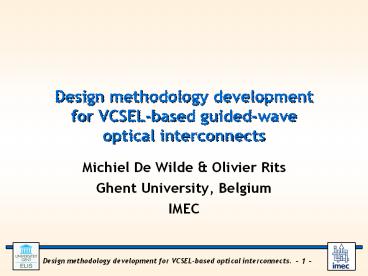Design methodology development for VCSEL-based guided-wave optical interconnects - PowerPoint PPT Presentation
1 / 22
Title:
Design methodology development for VCSEL-based guided-wave optical interconnects
Description:
for VCSEL-based guided-wave. optical interconnects. Michiel De Wilde & Olivier Rits. Ghent University, Belgium. IMEC ... Simulations to extract system-level properties ... – PowerPoint PPT presentation
Number of Views:148
Avg rating:3.0/5.0
Title: Design methodology development for VCSEL-based guided-wave optical interconnects
1
Design methodology developmentfor VCSEL-based
guided-waveoptical interconnects
- Michiel De Wilde Olivier Rits
- Ghent University, Belgium
- IMEC
2
Overview
- Optical interconnect
- rationale structure
- Optical interconnect design space
- exploration optimization
- Simulations to extract system-level properties
3
Optical interconnect rationale (1)
Moores Law
(source Intel)
- Denser inter-chip interconnect requirement
- Rising clock frequencies
4
Optical interconnect rationale (2)
ground plane
signal wire
A
wire length L
Inter-wire spacing area
- Wire capacitance resistance skin effect
- limit the electrical interconnect bandwidth B
(Miller-Ozaktas)
5
Optical interconnect rationale (3)
- Problematic interconnectbetween ICs and at the
IC access level - Industrial packet routers
- Some parallel and distributed processing systems
- Use of optics a solution on physical grounds
- No electromagnetic interference problems
- Almost distance frequency independent losses
- Optical I/O integration with CMOS
solvesinterconnect problems at the IC access
level
6
VCSEL-based parallel optical I/O
Connector
Fiber bundle
Package
PCB
VCSELs
Photodiodes
Solder balls
CMOS substrate (top side visible)
7
Fields involved
8
Complex design space
- Several approaches are possible
- Some continuously valued parameters too
- ?, operating currents, numerical aperture,
physical dimensions - Decisions in one field may affect other fields
Increase of numerical aperture of fiber
better coupling
less bend losses
worse coupling
(not to scale)
9
Design optimization
- Systematic way of making choices design
methodology - Designer states constraints
- Tool suggests good solutions meeting constraints
- Important system-level property categories
- Technological feasibility
- Performance (timing/power characteristics)
- Reliability
- Implementation cost
10
Design methodology development
11
Estimating timing/power/reliability
- Issues for direct estimation(e.g. from tabular
data) - Non-linear interactions between different
fields(electrical, optical, thermal) - Impact of noise and process variations
- Interconnect simulation
- Simulator
- Simulator models
- Stimuli
- Calculation of properties from simulation results
12
Simulator models
13
Simulator choice
- Device-level simulators
- OptiWave, RSoft, WinLase,
- Too detailed (some parameters are IP)
- Too slow for this purpose (finite-element
methods) - Circuit-level simulators
- SPICE, Verilog-AMS, VHDL-AMS,
- More concise parameter set possible
- Faster (only integration over time)
14
Example photodiode model
module pin_photodiode(in,anode,cathode)
input in inout anode, cathode power
in electrical anode, cathode parameter
real Cdep0, Cbo0, Rbas0, Resp0,
Id0 parameter real pole-1/(CdepRbas)
parameter real laplace_coeff_0CdepCbo
parameter real laplace_coeff_1CdepCboRbas
charge rc analog begin
I(cathode,anode) lt laplace_zp(RespPwr(in)Id,,
pole,0) Q(rc) lt laplace_np(V(cathode,a
node),laplace_coeff_0,laplace_coeff_1,pole,0)
end endmodule
- Terminals
- Model parameters
- Equations describing internal state and outputs
15
Driver/receiver model
- Normal analog electrical circuits
- IP protection no real circuit provided
- Alternative parameterised flowchart
- Validation measurementson non-hybridized CMOS
Receiver flowchart
Photocurrent input
Transimpedance preamplifier
Postamplifier
Equalizer
Decision circuit
Limiting amplifier
Digital output
16
VCSEL model
- Nonlinear differential equation system
- Jungo, et.al. VISTAS software package
- equations without spatial integration
- Difficult parameterization
- Validation measurements on non-hybridized VCSELs
17
Fiber-based optical path
- Abstraction of dispersion (short distance)
- Coupling coefficients for losses crosstalk
VCSEL-fiber crosstalk
Fiber-photodetector crosstalk
Fiber-photodetector coupling losses
VCSEL-fiber coupling losses
absorption
macrobend losses
Connectorlosses crosstalk
(not to scale)
18
Fiber bend losses
- Bend losses can be approximated using a
combination of raytracing results (H. Lambrecht,
et.al.) - Validation through optical path measurements
90 bend X axis NA fiber Y axis bending
radius Blue color high losses
(source H. Lambrecht)
19
Simulation illustration
(exaggerated VCSEL model parameters)
(inverted output)
20
Simulation setup
- Interconnection signals
- Digital pseudorandom
- Design-specific
- Parameters
- Process corners
- Monte-Carlo generated
- inter-device correlation
- Noise
- asynchronous
- synchronous
- mesochronous
- Predominant noise substrate noiseat the
receiver preamplifier - amplify some few µAof photocurrent
21
Conclusion
- Illustrated optical interconnect
- rationale structure
- Discussed optical interconnect design space
- exploration optimization
- Simulations to extract system-level properties
- Explained approach
- Discussed models
- Future work
22
Acknowledgements
- IST Interconnect by Optics project partners
- Hannes Lambrecht (Ghent University, IMEC-INTEC)
- Fiber bend losses modelling
- Marc Jungo
- VISTAS VCSEL modelling project
- Fund for Scientific Research Flanders (Belgium)
(F.W.O.) - Research assistantship































